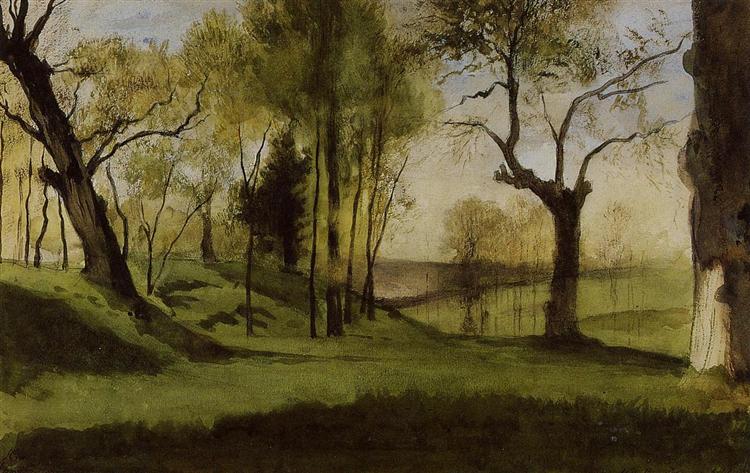Description
In a polyphony of the faint colors and an almost ethereal atmosphere, Gustave Moreau offers us an evocative vision of the majesty of a Renaissance building in "Villa Borghese Village - 1858". This work, created at an early stage of his career, is a testimony of the artist's particular sensitivity towards Italian urban landscapes and his ability to capture the essence of noble architecture.
The painting represents a bucolic view of the Villa Borghese, in Rome, bathed by a gently diffuse light that seems to wrap the entire stage in a mantle of serenity and contemplation. The choice of the town as a subject is not surprising; The site was and remains a luxury and splendor emblem with its gardens that resemble a living art work. Moreau, attached to his classical formation and his tendency towards the sublime, opts to exalt this magnificence through an approach that transcends the purely documentary and enters the dreamlike.
The composition of the work demonstrates a sharp sense of balance and proportion. The villa, slightly decentralized, allows the rest of the landscape to unfold harmoniously around, with particular attention to pyramidal formation trees that escort architecture as natural guardians. The contrast between the greenery of the vegetation and the earthly tones of the building creates a subtle visual tension that attracts and retains the viewer's gaze.
As for the technique, Moreau works with a color palette that echoes the masters of the quattrocento, but with a turn of modern sensitivity that prefigures its subsequent artistic development. The nuances of ocher, temples and green are mixed with almost thorough care, achieving a light effect that seems to emanate from within the painting itself. An intention is perceived to underline the timelessness of the place, caught at a perpetual moment of splendor.
While other contemporary artists from Moreau, such as Camille Corot, explored the faithful representation of nature and everyday scenes, Moreau leans towards the creation of an idealized, almost mythological reality. No human figures are observed in "Villa Borghese view"; However, the absence of characters does not remain life to the scene. On the contrary, he invites the viewer to fill that void with his own imagination, integrating into the landscape through an introspective contemplation.
In the historical and artistic context, this painting is inscribed in the tradition of late romanticism and predicts the iconographic obsessions that will dominate Moreau's work in his mature stage. Works such as "Oedipus and the Sphinx" or "Salome" already show that tendency to merge the historical with the legendary and the mystical. However, in his "view of the Villa Borghese", Moreaou faces the challenge of capturing the essence of a real place with the same reverence for mystery and the sublime.
This 1858 painting is not only a precursor to the symbolism that would influence Moreau, but also constitutes a bridge between its interpretation of the past and its futuristic vision of an evocative and overflowing art of meaning. Through his meticulous attention to detail and his refined sensitivity to color and light, Gustave Moreau manages to immortalize a fragment of the architectural history of Rome, transforming it into a poetic vision whose resonance is still felt today.
KUADROS ©, a famous paint on your wall.
Hand-made oil painting reproductions, with the quality of professional artists and the distinctive seal of KUADROS ©.
Art reproduction service with satisfaction guarantee. If you are not completely satisfied with the replica of your painting, we refund your money 100%.

